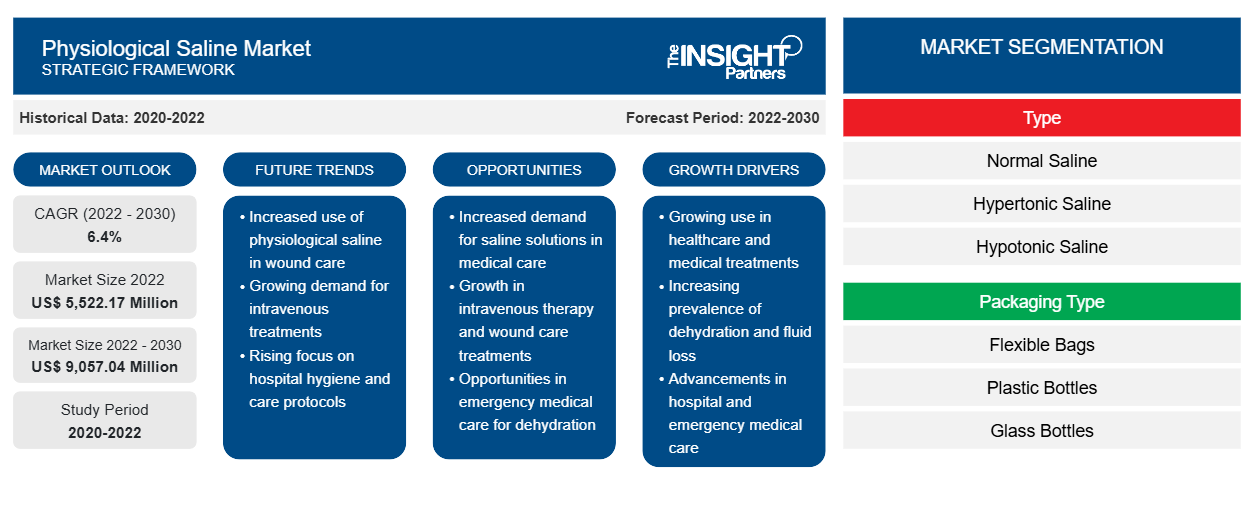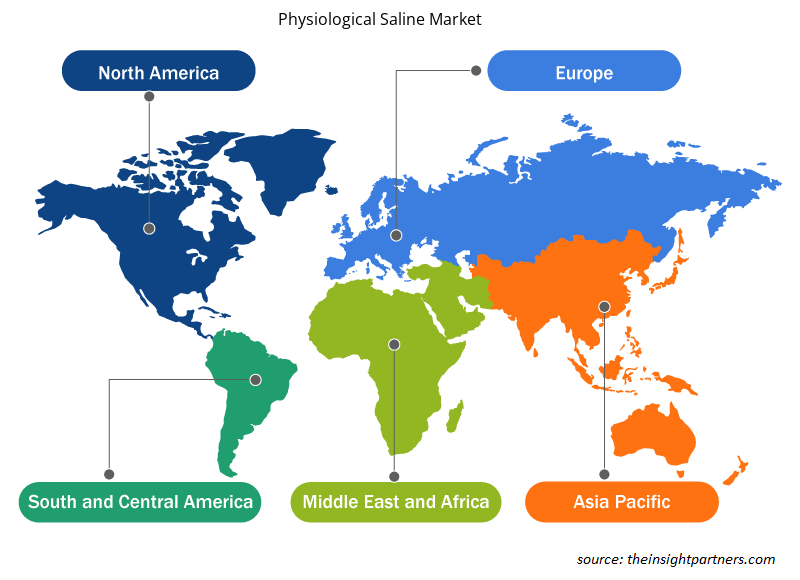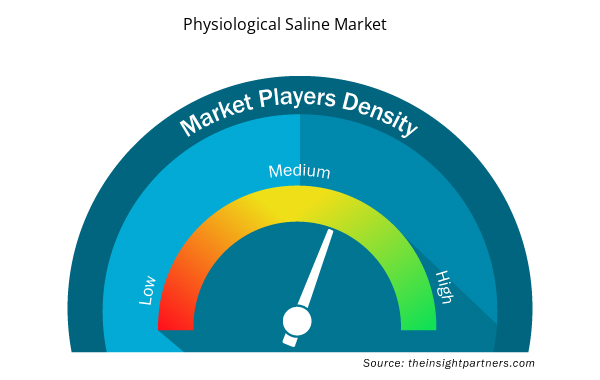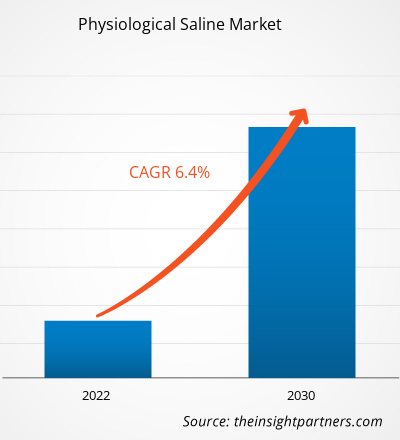[Research Report] The physiological saline market size is expected to grow from US$ 5,522.17 million in 2022 to US$ 9,057.04 million by 2030. The market is estimated to register a CAGR of 6.4% from 2022 to 2030.
Analyst’s Viewpoint
The physiological saline market analysis explains growth drivers such as the rising prevalence of serious illnesses and fluid electrolyte disorders, and surging demand for fluid electrolytes in the elderly population. Further, large-scale saline solution requirements in hospital settings are expected to emerge as new trends in the market during 2022–2030. The physiological saline market, by type, is segmented into normal saline, hypertonic saline, hypotonic saline, and balanced saline. The normal saline segment held the largest market share in 2022. However, hypertonic saline segment is anticipated to register the highest CAGR during 2022–2030. The physiological saline market, by packaging type, is segmented into flexible bags, plastic bottles, and glass bottles. The plastic bottles segment held the largest market share in 2022. The flexible bag segment is anticipated to register the highest CAGR during 2022–2030. The physiological saline market, by application, is segmented as intravenous, ophthalmology, wound care, endoscopy, skin abrasion, and others. The intravenous segment held the largest market share in 2022, and the same segment is anticipated to register the highest CAGR during 2022–2030. The physiological saline market, by route of administration, is categorized into intravenous and topical. The intravenous segment held a larger market share in 2022, and the same segment is anticipated to register a higher CAGR during 2022–2030. The physiological saline market, by end user, is segmented into hospitals, specialty clinics, ambulatory surgical centers, home care, and others. The hospitals segment held the largest market share in 2022. The specialty clinics segment is anticipated to register the highest CAGR during 2022–2030.
A physiological saline solution is composed of salt solutions that are isotonic and have the same pH. An example of a physiological saline solution is Ringer's solution, composed of a mixture of sodium chloride (NaCl), sodium bicarbonate, and potassium chloride solution. A physician recommends the administration of a physiological solution to treat cases of dehydration, fluid imbalance, and many other similar clinical abnormalities.
Market Insights
Rising Prevalence of Serious Illnesses and Fluid Electrolyte Disorders Propels Physiological Saline Market
People with serious illnesses often experience a profound loss of independence, time, and capabilities. The emotional, physical, and financial toll can be life-altering for people suffering from distress in addition to physical symptoms with specific mental conditions. According to statistics revealed by the Commonwealth Fund report, 62% of people with serious illness experience anxiousness, confusion, or helplessness. 48% have emotional or psychological problems caused by the condition, and 32% report feeling left out, lacking companionship, and isolated from others. A report by the National Health Council reveals that incurable and ongoing chronic diseases affect nearly 133 million Americans, which represents more than 40% of the total population of the country. Among these, almost 50% of all adults and nearly 8% of children aged 5–17 have a chronic condition. The National Health Council’s report also mentions that the increasing cases of incurable chronic diseases among Americans result in ~75% of the healthcare costs.
Serious illnesses result in an imbalance in body fluids, such as low levels of potassium, magnesium, calcium, and sodium in the body. Improper levels of body fluids negatively impact the body's function, muscle strength, and heart rhythm, which is associated with disorders of kidneys or endocrine glands. For example, edema occurs when the body retains excessive fluid levels, resulting in swelling and pain in the face, arms, legs, hands, and feet of patients. Further, losing more body fluids than consumed quantities results in dehydration, which eventually leads to symptoms such as thirst, weakness, lightheadedness, fainting, and decreased urine output among patients. Therefore, chronic illnesses may result in body fluid imbalance in the patient's body, which propels the demand for physiological saline that is administered as a part of their treatment. Thus, the rising prevalence of serious illnesses and fluid electrolyte disorders bolsters the physiological saline market growth.
Future Trend
Large-Scale Saline Solution Requirements in Hospital Settings
According to a report published by the Royal Society of Chemistry, using saline solution for washing red blood cells (RBCs) and treating critically ill patients is a common practice in hospital settings. Clinical research groups have reviewed the safety of using physiological saline (0.9% NaCl) in different clinical settings and suggested that the use of saline solution is one of the safest techniques in hospital settings. For example, in transfusion medicine, saline solution is used for washing cells and salvaging procedures in cases of apheresis and the resuscitation of patients with blood or fluid loss. Washing of RBCs requires 1–2 L of sterile saline solution. In the apheresis procedure, saline solution is used in therapeutic plasma exchange procedures and intra-operative cell salvaging to wash RBCs. Therefore, the multifaceted application of physiological saline on large scales in hospital settings is likely to emerge as a new trend in the physiological saline market.
Customize This Report To Suit Your Requirement
You will get customization on any report - free of charge - including parts of this report, or country-level analysis, Excel Data pack, as well as avail great offers and discounts for start-ups & universities
Physiological Saline Market: Strategic Insights

- Get Top Key Market Trends of this report.This FREE sample will include data analysis, ranging from market trends to estimates and forecasts.
Customize This Report To Suit Your Requirement
You will get customization on any report - free of charge - including parts of this report, or country-level analysis, Excel Data pack, as well as avail great offers and discounts for start-ups & universities
Physiological Saline Market: Strategic Insights

- Get Top Key Market Trends of this report.This FREE sample will include data analysis, ranging from market trends to estimates and forecasts.
Report Segmentation and Scope
Type-Based Insights
The physiological saline market, by type, is segmented into normal saline, hypertonic saline, hypotonic saline, and balanced saline. The normal saline segment held the largest market share in 2022; hypertonic saline segment is anticipated to register the highest CAGR during 2022–2030. Normal saline (NS) comprises a sterile salt solution used for short-term fluid replacement, as it helps restore electrolyte/salt levels in the body. It is a 0.9% sodium chloride solution intended to treat dehydration and electrolyte disturbances among people. NS is a cornerstone of intravenous solutions that are used commonly in clinical settings. It is suitable for both pediatric and adult patient populations. Primary indications for the use of NS solutions approved by the US Food and Drug Administration (FDA) are mentioned below:
- Extracellular fluid replacement to treat dehydration, hypovolemia, hemorrhage, sepsis, etc.
- Treatment of metabolic alkalosis in the presence of fluid loss
- Mild sodium depletion
Further, NS can only be administered through intravenous access, and the management of normal saline requires evaluation of the patient's health status. Pharmacists need to monitor the implementation of IV fluids while installing in the hospitals.
Packaging Type-Based Insights
The physiological saline market, by packaging type, is segmented into flexible bags, plastic bottles, and glass bottles. The plastic bottles segment held the largest market share in 2022. The flexible bags segment is anticipated to register the highest CAGR during 2022–2030. Sodium chloride (NaCl) USP solutions for injections are sterile and nonpyrogenic. They are parenteral solutions that contain various concentrations of NaCl in water for injection (WFI) intended for intravenous (IV) administration. Further, the flexible container is fabricated from a specially formulated polyvinyl chloride. However, solutions stored in plastic containers might trigger the leaching of certain chemical components from the plastic in tiny amounts. Nonetheless, the safety of plastic container materials can be tested effectively through biological evaluation methods. The plastic bottles segment is expected to account for the smallest share of the physiological saline market during the forecast period.
Application-Based Insights
The physiological saline market, by application, is segmented as intravenous, ophthalmology, wound care, endoscopy, skin abrasion, and others. The intravenous segment held the largest market share in 2022. It is further anticipated to register the highest CAGR during 2022–2030. Intravenous (IV) saline solutions are formulated for the prevention or treatment of dehydration. IV saline is prescribed by physicians for people who are injured, sick, dehydrated, or undergoing surgery, irrespective of their age. Saline IV bags provide a rapid and targeted solution to replenish fluids and relieve symptoms. Furthermore, a combination of sterile water and sodium chloride, or salt and normal saline IVs, helps restore fluid balance and hydrate tissues among patients. IV saline is commonly administered directly into patients’ bloodstreams when they require hydration. It is considered a suitable option for people with allergies or sensitivities to specific medications.
Various companies are offering innovative IV saline products; for example, Fresenius Kabi USA offers "freeflex" and "freeflex+ IV bags." These products also provide leak prevention, sterility protection, and needle-stick prevention.
Route of Administration-Based Insights
The physiological saline market, by route of administration, is categorized into intravenous and topical. The intravenous segment held the largest market share in 2022. The market for this segment is anticipated to register the highest CAGR during 2022–2030. IV saline solutions are specially formulated liquids that are injected into a vein to prevent and treat dehydration. Also, these IV fluids are utilized among people of all ages suffering from sickness, injury, dehydration, etc. The IV saline solution is administered via a simple and safe procedure that is associated with a low risk of complications. Also, fluid resuscitation is a vital component for the management of acutely ill patients, and normal saline is considered to be the most widely used IV fluid for seriously ill or injured patients. Being a common, simple, and safe procedure, patients administered via the IV route may feel relief in a short span.
Physiological Saline Market Regional Insights
Physiological Saline Market Regional Insights
The regional trends and factors influencing the Physiological Saline Market throughout the forecast period have been thoroughly explained by the analysts at Insight Partners. This section also discusses Physiological Saline Market segments and geography across North America, Europe, Asia Pacific, Middle East and Africa, and South and Central America.

- Get the Regional Specific Data for Physiological Saline Market
Physiological Saline Market Report Scope
| Report Attribute | Details |
|---|---|
| Market size in 2022 | US$ 5,522.17 Million |
| Market Size by 2030 | US$ 9,057.04 Million |
| Global CAGR (2022 - 2030) | 6.4% |
| Historical Data | 2020-2022 |
| Forecast period | 2022-2030 |
| Segments Covered |
By Type
|
| Regions and Countries Covered | North America
|
| Market leaders and key company profiles |
Physiological Saline Market Players Density: Understanding Its Impact on Business Dynamics
The Physiological Saline Market market is growing rapidly, driven by increasing end-user demand due to factors such as evolving consumer preferences, technological advancements, and greater awareness of the product's benefits. As demand rises, businesses are expanding their offerings, innovating to meet consumer needs, and capitalizing on emerging trends, which further fuels market growth.
Market players density refers to the distribution of firms or companies operating within a particular market or industry. It indicates how many competitors (market players) are present in a given market space relative to its size or total market value.
Major Companies operating in the Physiological Saline Market are:
- Fresenius Kabi AG
- Merck KGaA
- AdipoGen Life Sciences Inc
- Enzo Life Sciences Inc
- ICU Medical Inc
Disclaimer: The companies listed above are not ranked in any particular order.

- Get the Physiological Saline Market top key players overview
Regional Analysis
Asia Pacific is expected to register the highest CAGR in the global physiological saline market during 2022–2030. The market in Asia Pacific is segmented into China, India, Japan, South Korea, Australia, and the Rest of Asia Pacific. China holds the largest share of the physiological saline market in Asia Pacific. The physiological saline market growth in China during 2020–2030 is ascribed to the rising chronic disease incidences. According to the National Health Commission of the People's Republic of China, more than 300 million patients have been diagnosed with chronic diseases, accounting for 86.6% of the total chronic disease deaths. China also reports the second-highest number of tuberculosis (TB) cases. In 2020, nearly 842,000 people were diagnosed with TB in China, as per the statistics revealed by the Centers for Disease Control and Prevention (CDC). Likewise, chronic diseases among the patients have resulted in accelerated demand for physiological saline. The UCLA Health 2023 report reveals that the medical community understood the role of dietary science and nutrition in chronic disease progression. Therefore, simple strategies such as reducing sodium intake as well as minimizing added refined sugar and saturated fat consumption can help prevent diet-associated illnesses and promote overall wellness. This nutritional content is supplied through a physiological saline solution comprising salts (sodium and potassium), sugars (carbohydrates and glucose), plant-based and animal-source diets, water intake for wellness, coffee and tea, fruit juice or soda, and so on.
The report profiles leading players operating in the physiological saline market. These include Fresenius Kabi AG, Merck KGaA, AdipoGen Life Sciences Inc, Enzo Life Sciences Inc, ICU Medical Inc, Grifols SA, Geno Technology Inc, B Braun Medical Inc, Pfizer Inc, and Ward's Science.
- Historical Analysis (2 Years), Base Year, Forecast (7 Years) with CAGR
- PEST and SWOT Analysis
- Market Size Value / Volume - Global, Regional, Country
- Industry and Competitive Landscape
- Excel Dataset



Report Coverage
Revenue forecast, Company Analysis, Industry landscape, Growth factors, and Trends

Segment Covered
Type, Packaging Type, Application, Route of Administration, and End User

Regional Scope
North America, Europe, Asia Pacific, Middle East & Africa, South & Central America

Country Scope
This text is related
to country scope.
Frequently Asked Questions
The physiological saline market majorly consists of the players such Fresenius Kabi AG, Merck KGaA, AdipoGen Life Sciences Inc, Enzo Life Sciences Inc, ICU Medical Inc, Grifols SA, Geno Technology Inc, B Braun Medical Inc, Pfizer Inc, and Ward's Science, and amongst others.
Global physiological saline market is segmented by region into North America, Europe, Asia Pacific, the Middle East & Africa, and South & Central America. North America held the largest market share of the physiological saline market in 2022.
Fresenius Kabi AG and B Braun Medical Inc are the top two companies that hold huge market shares in the physiological saline market.
Physiological saline is a 0.9% sodium chloride (NaCl) solution referred to as "physiological" containing isotonic solution with an osmotic pressure equivalent to that of body fluids under normal conditions. To create physiological saline, people dissolve 9g of pure salt with 1 liter of distilled water. Currently, physiological saline has dosage forms such as bottles of solution for infusion, physiological saline eye drops, nose drops, and ear drops, usually available in the form of 100ml, 250ml, and 500ml.
The normal saline segment held the largest share of the market in the global physiological saline market in 2022.
The CAGR value of the physiological saline market during the forecasted period of 2022-2030 is 6.4%.
The intravenous (IV) segment dominated the global physiological saline market and held the largest market share in 2022.
Key factors that are driving the growth of this market are rising prevalence of serious illnesses and fluid electrolytes disorders and surging demand for fluid electrolytes in ageing population are expected to boost the market growth for the physiological saline over the years.
Trends and growth analysis reports related to Life Sciences : READ MORE..
The List of Companies - Physiological Saline Market
- Fresenius Kabi AG
- Merck KGaA
- AdipoGen Life Sciences Inc
- Enzo Life Sciences Inc
- ICU Medical Inc
- Grifols SA
- Geno Technology Inc
- B Braun Medical Inc
- Pfizer Inc
- Ward's Science

 Get Free Sample For
Get Free Sample For